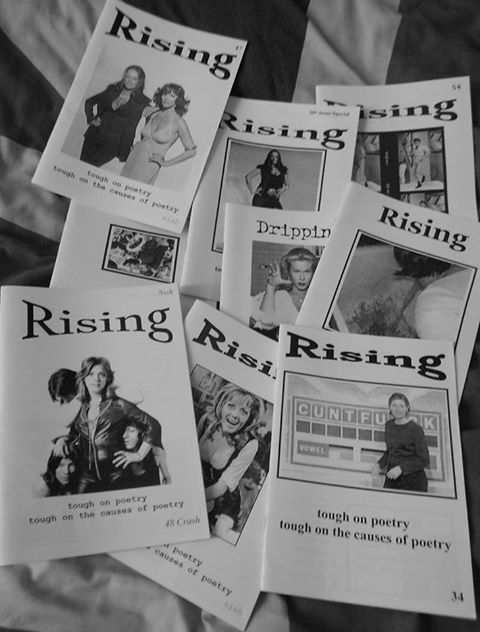Inky Needles:The Body Modern
-Reviewed by Alex Campbell–
Initial impressions from the cover of “The Body Modern”, the first print edition of Inky Needles, suggest that my editor may have mistaken me for an art critic. The strange, retro design of the cover which seems to hark back to Victorian periodicals – possibly capitalising on the current vogue for Steampunk and the Neo-Gothic – invokes both a nostalgia for the age of invention and the idea of mingling visual arts with poetical ones; an aim of which I heartily approve, especially when the result is so aesthetically pleasing.
Not only is this a very good looking collection, but between the covers it is equally satisfying. The political/philosophical articles are very erudite, as one would expect from such a base of academically inclined contributors, and it becomes hard to comment on the form without commenting on the subject, running the risk of occasionally reviewing a review. For example, Jessica Gregory’s short article “The Travesty of Men” which draws an interesting comparison between two art exhibits, but which could have explored the subjects and the implications more deeply. To mention the male gaze and then not discuss how this gaze of the male upon itself compares to male upon female gazing (especially when one of the exhibits in question contains examples of the male form feminised) misses a trick, and an added complexity which would have elevated the article from an already sound piece to a more rigorous and encompassing level.
While articles like Wayne Holloway-Smith’s “Dick in Hand” provide a thorough and engaging examination of the subject matter, other articles are marginally less satisfying. The emailed asides in “Margins that Matter” (Alice Butler and Jane Cleasby), while probably included to underscore the point made, seem almost to provide a counterexample to it. Instead of the asserted “continuous retching in spurts and splutters and ‘OH BTW-‘” it becomes a shorthand. Meaning is condensed, not vomited up. The frequent inclusion of expletives is not as radical as the authors seem to think it is, and the use of the little email asides, again, does not entirely seem to serve the purpose intended. Instead of constantly bombarding the reader with a flood of information, “an infinite splurge” “meaning… so surplus it decimates form,” it actually slows down the piece, making it less aggressive, less gross, and punctuating the wall of criticism with a humanising, breathy aside. This humanisation also brings the authors into the foreground, somewhat undercutting their suggestion that “the inscriber is unknown”.
The overall postulations of the article are fascinating – the assertions, for example, that the “unplanned and unpredictable”, “unpremeditated… automated, visceral act” of internet / email communication is somehow sexier because of its transience and lack of filters, and that the position taken by epistolary writing between the oral and the textual is somehow more real, more engaging, more human and physical than a planned, structured effort (which sadly ignores the possibility of spell-checkers and proof-reading before hitting the “send” button…). And yet, despite their efforts, I am not certain that Butler and Cleasby practice what they preach to the extent they intend. In the end, they still have to resort to clear, studied critical prose to convey their point, and just using “fucking” every chance they get is not as transgressive as the actual ideas, which ought to be able to stand alone without the profanity.
The quality of the poetry is exceedingly high in this collection. Like the prose, this feels like a very educated, challenging selection, yet at the same time it has an accessibility which makes it devoid of pretension.
There is a general economy of language and a streamlined simplicity to many of these poems that surreptitiously manages to convey quite complex ideas – as in Ricky Howries’s “The Symbol Includes Itself,” an exploration of the interconnectedness of the physical and intellectual and the differing values we ascribe to sensation and reason – and emotions – such as “Insider” by Annabel Banks, a poem as disconcerting as it is compelling. Without over-burdening themselves with excess, the imagery is allowed to shine through; “I want to draw ice fields / stained with rose where / the sun recedes. Chains / of light on our wrists / and ankles.” (“The Stupor is Over” by Chloe Stopa-Hunt.)
There is no weak link in the poetry. From the elegant “Metonymy” by Constantin Preda, to the richly textured “At Brownwater Pond” (AE Ballakisten), these are all poems which engage, challenge and stimulate the reader. And whilst I was occasionally left cold by the prose, overall this collection is hard to find fault with. I would have liked to see more texts that played with notions of form, eg “Human Eye” (p19) which, like the cover (both inside and out) contrasts nostalgic form with modern content, mingling the verbal and the visual. But on the whole, “The Body Modern” is an exceptionally mature collection of work, elegantly pieced together; form and function working for the most part in effortless tandem. Mens sana in corpore sano, indeed.



